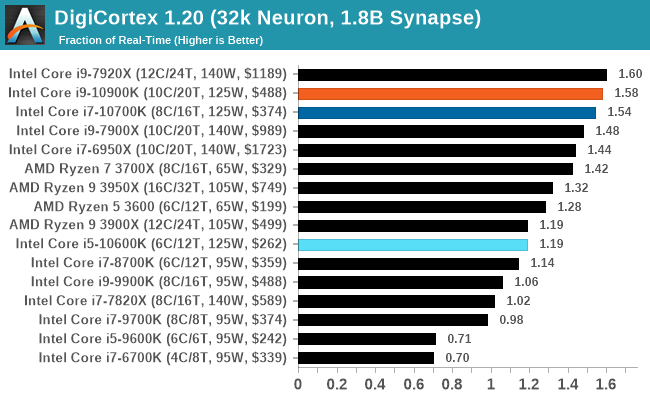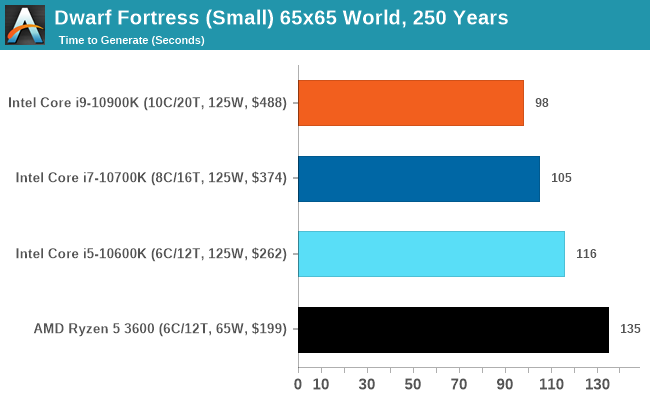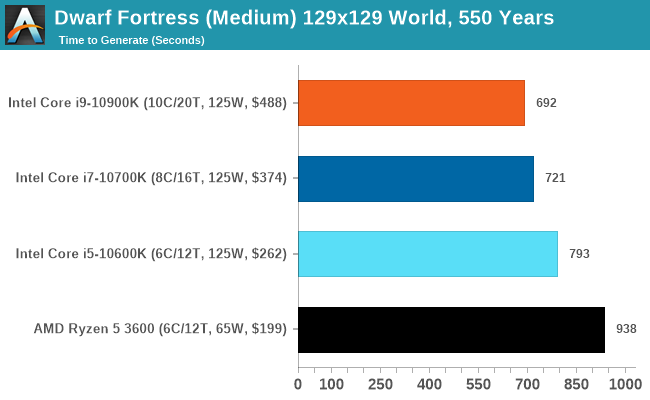The Intel Comet Lake Core i9-10900K, i7-10700K, i5-10600K CPU Review: Skylake We Go Again
by Dr. Ian Cutress on May 20, 2020 9:00 AM EST- Posted in
- CPUs
- Intel
- Skylake
- 14nm
- Z490
- 10th Gen Core
- Comet Lake
CPU Performance: Simulation Tests
A number of our benchmarks fall into the category of simulations, whereby we are either trying to emulate the real world or re-create systems with systems. In this set of tests, we have a variety including molecular modelling, non-x86 video game console emulation, a simulation of the equivalent of a slug brain with neurons and synapses firing, and finally a popular video game that simulates the growth of a fictional land including historical events and important characters within that world.
NAMD ApoA1
One frequent request over the years has been for some form of molecular dynamics simulation. Molecular dynamics forms the basis of a lot of computational biology and chemistry when modeling specific molecules, enabling researchers to find low energy configurations or potential active binding sites, especially when looking at larger proteins. We’re using the NAMD software here, or Nanoscale Molecular Dynamics, often cited for its parallel efficiency. Unfortunately the version we’re using is limited to 64 threads on Windows, but we can still use it to analyze our processors. We’re simulating the ApoA1 protein for 10 minutes, and reporting back the ‘nanoseconds per day’ that our processor can simulate. Molecular dynamics is so complex that yes, you can spend a day simply calculating a nanosecond of molecular movement.
This is one of our new tests, so we will be filling in more data as we start regression testing for older CPUs.

Dolphin 5.0: Console Emulation
One of the popular requested tests in our suite is to do with console emulation. Being able to pick up a game from an older system and run it as expected depends on the overhead of the emulator: it takes a significantly more powerful x86 system to be able to accurately emulate an older non-x86 console, especially if code for that console was made to abuse certain physical bugs in the hardware.
For our test, we use the popular Dolphin emulation software, and run a compute project through it to determine how close to a standard console system our processors can emulate. In this test, a Nintendo Wii would take around 1050 seconds.
The latest version of Dolphin can be downloaded from https://dolphin-emu.org/

DigiCortex 1.20: Sea Slug Brain Simulation
This benchmark was originally designed for simulation and visualization of neuron and synapse activity, as is commonly found in the brain. The software comes with a variety of benchmark modes, and we take the small benchmark which runs a 32k neuron / 1.8B synapse simulation, equivalent to a Sea Slug.
Example of a 2.1B neuron simulation
We report the results as the ability to simulate the data as a fraction of real-time, so anything above a ‘one’ is suitable for real-time work. Out of the two modes, a ‘non-firing’ mode which is DRAM heavy and a ‘firing’ mode which has CPU work, we choose the latter. Despite this, the benchmark is still affected by DRAM speed a fair amount.
DigiCortex can be downloaded from http://www.digicortex.net/

The additional bandwidth of the HEDT platforms put them higher up the chart here - Digicortex always ends up as an odd mix of bottlenecks mostly around memory, but it can be localized internal bandwidth limited as well.
Dwarf Fortress
Another long standing request for our benchmark suite has been Dwarf Fortress, a popular management/roguelike indie video game, first launched in 2006. Emulating the ASCII interfaces of old, this title is a rather complex beast, which can generate environments subject to millennia of rule, famous faces, peasants, and key historical figures and events. The further you get into the game, depending on the size of the world, the slower it becomes.
DFMark is a benchmark built by vorsgren on the Bay12Forums that gives two different modes built on DFHack: world generation and embark. These tests can be configured, but range anywhere from 3 minutes to several hours. I’ve barely scratched the surface here, but after analyzing the test, we ended up going for three different world generation sizes.
This is another of our new tests.














220 Comments
View All Comments
UltraWide - Wednesday, May 20, 2020 - link
Intel's 10th gen is a hard pass for me.I'll wait patiently with my 4770K.
Spunjji - Tuesday, May 26, 2020 - link
Haswell was the last time I remember being excited about an Intel CPU.AnarchoPrimitiv - Wednesday, May 20, 2020 - link
Why is the article stating that the 10900k is "around the same price" as the 3900x when its literally around $100 more (3900x currently goes for $417 and the 10900k has listed at $522, $488 is only the tray price when you buy 1000 or more CPUs)? In my opinion a 25% more expensive CPU isn't "around the same price"dirkdigles - Wednesday, May 20, 2020 - link
Same thoughts - I commented on that earlier. Quite misleading IMO.drothgery - Wednesday, May 20, 2020 - link
comparing retail prices of something just released vs something that's been out for months is silly, so they went by MSRP (which for CPUs is the tray price)?GreenReaper - Wednesday, May 20, 2020 - link
Don't see how that works. You buy based on the performance available now, that is what the charts are based on - so why not the price now?duploxxx - Wednesday, May 20, 2020 - link
perhaps a reviews site should start testing with the defaults…. so put a default cooler on this system and test again in a case and heating next to it and see how much is reall left from this marketing turbo and theoretical benchmarking....jameslr - Wednesday, May 20, 2020 - link
What's a "default cooler"? None of these CPUs come with a "cooler" or HSF unit.GreenReaper - Wednesday, May 20, 2020 - link
So test it anyway, see what happens when you don't include a vital bit of kit in the comparison price.Spunjji - Tuesday, May 26, 2020 - link
The AMD ones do. They could throw in a known-equivalent cooler on the Intel side and repeat a few of the tests with it to see how it fares - one of those $30 Coolermaster jobs should do the trick.At least that way you'd get an idea of the extremes - "properly" cooled with a water loop vs. cooled the way most people used to do home builds.